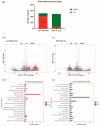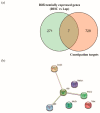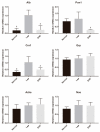Study on Anti-Constipation Effects of Hemerocallis citrina Baroni through a Novel Strategy of Network Pharmacology Screening
- PMID: 36902274
- PMCID: PMC10003546
- DOI: 10.3390/ijms24054844
Study on Anti-Constipation Effects of Hemerocallis citrina Baroni through a Novel Strategy of Network Pharmacology Screening
Abstract
Daylily (Hemerocallis citrina Baroni) is an edible plant widely distributed worldwide, especially in Asia. It has traditionally been considered a potential anti-constipation vegetable. This study aimed to investigate the anti-constipation effects of daylily from the perspective of gastro-intestinal transit, defecation parameters, short-chain organic acids, gut microbiome, transcriptomes and network pharmacology. The results show that dried daylily (DHC) intake accelerated the defecation frequency of mice, while it did not significantly alter the levels of short-chain organic acids in the cecum. The 16S rRNA sequencing showed that DHC elevated the abundance of Akkermansia, Bifidobacterium and Flavonifractor, while it reduced the level of pathogens (such as Helicobacter and Vibrio). Furthermore, a transcriptomics analysis revealed 736 differentially expressed genes (DEGs) after DHC treatment, which are mainly enriched in the olfactory transduction pathway. The integration of transcriptomes and network pharmacology revealed seven overlapping targets (Alb, Drd2, Igf2, Pon1, Tshr, Mc2r and Nalcn). A qPCR analysis further showed that DHC reduced the expression of Alb, Pon1 and Cnr1 in the colon of constipated mice. Our findings provide a novel insight into the anti-constipation effects of DHC.
Keywords: 16S rRNA; constipation; daylily; network pharmacology; transcriptomes.
Conflict of interest statement
The authors declare no conflict of interest.
Figures







References
-
- Zhao Y., Zhang C.C., Yu L.L., Tian F.W., Zhao J.X., Zhang H., Chen W., Zhai Q.X. Strain-specific effect of Limosilactobacillus fermentum with distinct genetic lineages on loperamide-induced constipation in mice: Attributing effects to certain genes. Food Funct. 2022;13:12742–12754. doi: 10.1039/D2FO02675A. - DOI - PubMed
MeSH terms
Substances
Grants and funding
- NZ2021032/Lingnan Modern Agricultural Science and Technology Guangdong Laboratory Independent Scientific Research Project
- 2020B1212060059/Guangdong Provincial Key Laboratory of Food Quality and Safety
- 2019B020211002/Key Realm R&D Program of Guangdong Province
- 202102080615/Science and Technology Planning Project of Guangzhou City
- 2017/Project Supported by Guangdong Province Universities and Colleges Pearl River Scholar Funded Scheme
LinkOut - more resources
Full Text Sources
Medical
Miscellaneous

